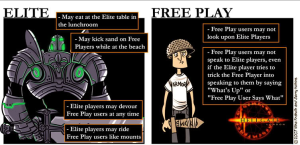As Free to Play design has swept over the Game Industry, so has the term “Pay to Win” which has become the most damning thing to say about F2P game and is usually the nail in the coffin for most titles. Over the last few years we’ve been dancing around the term and some people just call any F2P game pay to win. After beginning to run out of steam playing Marvel Puzzle Quest, I felt that it was the perfect opportunity to settle on some guidelines for the term. Today, gaming has a long history and has remained a popular pastime over the years, attracting people from all corners of the world. The casino offers a wide variety of gambling entertainment, you can learn extra about it here. ”
As we’ve talked about in the past, microtransactions and DLC are not inherently good or bad systems, but how they are implemented in the game that determines that. Pay to win is considered by gamers to be the worse form of F2P design and there are several determining factors as to if a game is pay to win or not.
Pricey Progression:
The ultimate goal of any F2P game for the designer is to hopefully bring money in. But the way that the designer achieves this can fluctuate and affects the quality of the game. The first sign that a game is pay to win is if playing the game requires an ever escalating amount of real money purchases.
We see this trend in social games and a lot of F2P mobile games. When you first start playing the microtransactions are kept very small and you’re free to make a decent amount of progress without spending any money. But as you get further in the game, the cost of playing begins to rise.
Either the game begins to become frustrating unless you spend money or in order to achieve the same amount of progress you’ve been making, requires money.
There are many ways that designers can do this: Pay or Wait mechanics, punishments that are negated by spending money, purchasable boosts that can only be bought with cash and so on.

Social games like Farmville begin with rapid progression that tapers off as the player becomes more invested in the game.
The classic trick is that the first few hours of play have barely any microtransactions in order to rope someone in. And then once they become invested in the game, it will be that much easier to convince them to spend money in order to progress.
And thanks to the ease that new content or purchases can be created, this cost can be continually escalated over the course of a game’s lifespan, getting more and more money out of the fan base or the whales.
Money Makes the World Go Round:
Next is a big red flag to any gamer– When money provides an objectively better experience when playing, meaning that if the purchasable content creates a noticeable distinction between the haves and the have-nots.
“Better Experience” includes in game advantages, stronger in game gear or anything that makes the paying players stand above the free players.
This is especially a major deal in games with competitions or PVP play. With the F2P Battlefield game from a few years ago, people were “surprised” when after introducing competitive advantages to the microtransaction system that the amount of money the game made went up.
In any competitive atmosphere, if money can provide an advantage then of course people are going to look for ways to win. And yes, that means big bucks for the designers who keep playing the digital arms race.
And the beauty of an arms race? You can keep raising the power curve and the utility of these higher priced weapons, for example: For the first month of play, the top tier weapon does 500 points of damage. Then the designers will release a premium rifle that does 550 points of damage and so on.
Besides direct benefits, this category also includes spending money for in game advantages or an “elite status.” This can be tricky to define but we can say that anything that provides a noticeable difference in how the game is played can be applied here.

Team Fortress 2 allows players to collect almost anything in the game given enough time or money spent at it.
Such as saying that anyone with an elite status gets all their equipment repaired for free, while free players will have to constantly spend in game resources.
Or that gear at a certain rarity tier cannot be worn by free players and that it is only available to those with a premium account.
Both direct benefits and indirect benefits of spending money are designed to elicit two different responses with the same goal to get people to buy stuff.
For those who’ve already spent money: They’re the elites, the special few with the best weapons and in-game advantages. They have a greater chance at winning tournaments or matches which keeps giving them more accolades. In order to keep being the best, they have to spend money or the alternative is going back to being one of the “unwashed masses.”
And for those who haven’t: They’re the dregs, barely able to compete against the elites. With every disadvantage levied against them, they can only look from the outside in at the people who are able to enjoy the game at its fullest. The allure of moving up to the higher ranks is present and the only way to do that is with a credit card.
Of course this raises an important question: What’s the better alternative? F2P is obviously very lucrative when done right and the games that have achieved this are making beaucoup bucks.
Bargain Buyers:
There are two popular ways that have worked in the past, first is always providing an alternative to spending money. In Team Fortress 2 for instance, you can get access to just about everything in game through the Mann Co store for the right price. But the game also lets these same items drop randomly through play– or in other words, not forcing the player to spend money.
Valve talked about this in blog posts and presentations in the past. They came to the conclusion that the best way to get people interested in playing the game and going after these items was connecting them to a perceived value. Either a time value or spending X amount of minutes to unlock an item, or a monetary value of just letting the player buy an item.
Either way, the item has an associated weight to it that incentivizes going after it without providing an objective advantage to the people who spend a lot of money.
If you can’t aim as a soldier, then it doesn’t matter how many rocket launchers you buy compared to someone who knows what they’re doing.
The other option is very simple: Money cannot be used to buy any in-game advantages. Instead, monetary purchases are restricted to cosmetic or aesthetic purchases that help the player stand out but not impact playing the game. Obviously the big examples of this are the premium skins in League of Legends or the different character pieces in Card Hunter.
Someone can spend hundreds of dollars in terms of skins for League of Legends and it won’t mean anything when it comes time for a ranked match. And while buying heroes is an important part of playing competitively, all champions can be bought with in game currency and there are constant sales available.
The Two Types of Value:
After this entire post, we can simply define a game as pay to win with the following definition:
If there are any unique purchases that positively impacts the game experience and are only available with premium currency (aka real money), then the game is considered Pay to Win.
What’s important to keep in mind with that definition is the phrase “only available with premium currency.” If you’re trying to create a balanced PVP experience and at the same time are selling enhanced equipment that is only available with premium currency, then you are creating an imbalanced environment between the haves and the have-nots.
This is why it is always better to have any game impacting purchases available under both in game currency and premium. The reason is that both have a perceived value of either time or money respectively.
And it is what Valve figured out and how they managed to convert Team Fortress both to a F2P game and added microtransactions with amazing success. Someone with a lot of money can just go onto the Mann CO store and buy every single item on there. But at the same time through just playing a game, someone will unlock items gradually.

The new shield item has become an important tool for tournament play and can only be bought using premium currency and is a perfect example of Pay To Win at work.
In both cases, each player perceives either time or money as the more important factor.
The former doesn’t want to feel forced to spend money while the latter doesn’t want to waste their time without the items.
Either way the game compensates their play style without punishing the other.
So while yes, someone with a lot of money can play with more of Team Fortress 2’s toys earlier, you can still get there without spending one penny. Or maybe an occasional buy of an item you really want or as a show of support to the developers.
Bringing this back to Marvel Puzzle Quest for a second, they just introduced an item called a shield to their tournament mode. Putting a shield on costs premium currency and prevents other players from attacking your team and costing you points which determines your ranking at the end of a tournament.
Now, you can’t attack anyone or raise your point total while having a shield on, but considering that people can’t attack you and take your points, it’s a powerful item. But since it’s only available to people with premium currency (with stronger versions that cost more and last longer) it is a perfect example of a Pay to Win item.
Pay To Win as we’ve talked about can be the nail in the coffin for any F2P game, especially those aimed at moderate to expert gamers. The people who won’t be blinded or not knowledgeable on the tricks and tactics of popular Free to Play design. And while Pay To win can provide short term benefits; it’s not what you want to use if you want to create a long lasting game like League of Legends.




Pingback: Hearthstone Heroes Of Warcraft: Stacking The Deck | Game Wisdom()